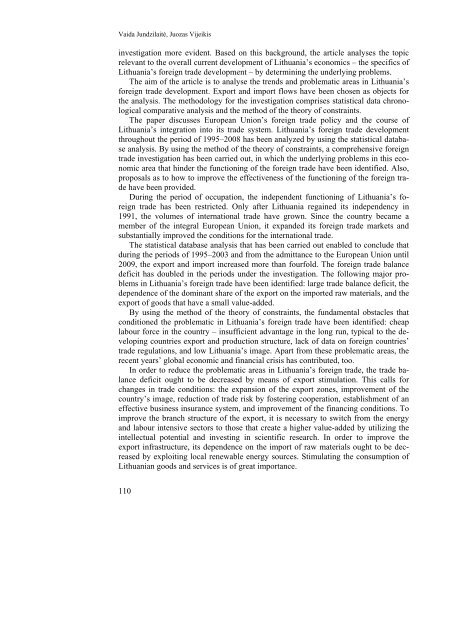2011,4 (57) - KlaipÄdos universitetas
2011,4 (57) - KlaipÄdos universitetas
2011,4 (57) - KlaipÄdos universitetas
You also want an ePaper? Increase the reach of your titles
YUMPU automatically turns print PDFs into web optimized ePapers that Google loves.
Vaida Jundzilaitė, Juozas Vijeikis<br />
investigation more evident. Based on this background, the article analyses the topic<br />
relevant to the overall current development of Lithuania’s economics – the specifics of<br />
Lithuania’s foreign trade development – by determining the underlying problems.<br />
The aim of the article is to analyse the trends and problematic areas in Lithuania’s<br />
foreign trade development. Export and import flows have been chosen as objects for<br />
the analysis. The methodology for the investigation comprises statistical data chronological<br />
comparative analysis and the method of the theory of constraints.<br />
The paper discusses European Union’s foreign trade policy and the course of<br />
Lithuania’s integration into its trade system. Lithuania’s foreign trade development<br />
throughout the period of 1995–2008 has been analyzed by using the statistical database<br />
analysis. By using the method of the theory of constraints, a comprehensive foreign<br />
trade investigation has been carried out, in which the underlying problems in this economic<br />
area that hinder the functioning of the foreign trade have been identified. Also,<br />
proposals as to how to improve the effectiveness of the functioning of the foreign trade<br />
have been provided.<br />
During the period of occupation, the independent functioning of Lithuania’s foreign<br />
trade has been restricted. Only after Lithuania regained its independency in<br />
1991, the volumes of international trade have grown. Since the country became a<br />
member of the integral European Union, it expanded its foreign trade markets and<br />
substantially improved the conditions for the international trade.<br />
The statistical database analysis that has been carried out enabled to conclude that<br />
during the periods of 1995–2003 and from the admittance to the European Union until<br />
2009, the export and import increased more than fourfold. The foreign trade balance<br />
deficit has doubled in the periods under the investigation. The following major problems<br />
in Lithuania’s foreign trade have been identified: large trade balance deficit, the<br />
dependence of the dominant share of the export on the imported raw materials, and the<br />
export of goods that have a small value-added.<br />
By using the method of the theory of constraints, the fundamental obstacles that<br />
conditioned the problematic in Lithuania’s foreign trade have been identified: cheap<br />
labour force in the country – insufficient advantage in the long run, typical to the developing<br />
countries export and production structure, lack of data on foreign countries’<br />
trade regulations, and low Lithuania’s image. Apart from these problematic areas, the<br />
recent years’ global economic and financial crisis has contributed, too.<br />
In order to reduce the problematic areas in Lithuania’s foreign trade, the trade balance<br />
deficit ought to be decreased by means of export stimulation. This calls for<br />
changes in trade conditions: the expansion of the export zones, improvement of the<br />
country’s image, reduction of trade risk by fostering cooperation, establishment of an<br />
effective business insurance system, and improvement of the financing conditions. To<br />
improve the branch structure of the export, it is necessary to switch from the energy<br />
and labour intensive sectors to those that create a higher value-added by utilizing the<br />
intellectual potential and investing in scientific research. In order to improve the<br />
export infrastructure, its dependence on the import of raw materials ought to be decreased<br />
by exploiting local renewable energy sources. Stimulating the consumption of<br />
Lithuanian goods and services is of great importance.<br />
110
















